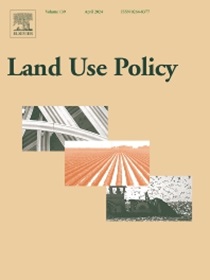农地利用横向碳补偿:促进农地资源公平利用的政策工具
IF 5.9
1区 社会学
Q1 ENVIRONMENTAL STUDIES
引用次数: 0
摘要
碳补偿政策被广泛认为是有效的减排工具。随着农田碳预算在气候治理中越来越重要,平衡粮食生产与减排和碳封存已成为一项紧迫挑战。本研究提出了农地利用水平碳补偿的理论框架,旨在促进中国农业碳治理的公平、高效和可持续。利用城市层面的数据,分析了耕地碳收支的时空动态,评价了区域差异对补偿结果的影响,并评估了HCCCU机制的可行性和有效性。我们的研究结果显示,在全国范围内,耕地排放呈现出高峰后下降的趋势,而碳固存呈现出稳定增长的趋势。南方地区的排放量较高,特别是粮食主产区,是主要的排放热点。在调整区域差异后,排放和固存许可量在南方减少,而在东北增加,反映出显著的空间不平等。调整后的HCCCU表明,粮食主产区是补偿的主要受益者,累计补偿金额与估计补偿需求基本一致。这种平衡强调了考虑区域差异以确保公平的极端重要性。补偿的主要贡献者包括川渝、华北、东南沿海地区和经济发达的城市,而东北中部和北部边境地区被确定为优先受益者。总体而言,本研究为HCCCU方案的实施提供了理论基础和实践指导,支持区域差别化战略的公平减排和可持续耕地管理。本文章由计算机程序翻译,如有差异,请以英文原文为准。
Horizontal carbon compensation for cropland use: A policy tool for promoting the equitable utilization of cropland resources
Carbon compensation policies are widely recognized as effective emission reduction tools. As cropland carbon budgets gain importance in climate governance, balancing food production with emissions mitigation and carbon sequestration has become an urgent challenge. This study proposes a novel theoretical framework for horizontal carbon compensation for cropland use (HCCCU), which aims to promote equitable, efficient, and sustainable agricultural carbon governance in China. Using the city-level data, we analyze the spatiotemporal dynamics of cropland carbon budgets, evaluate the effects of regional disparities on compensation outcomes, and assess the feasibility and effectiveness of the mechanism of HCCCU. Our findings reveal a peak-then-decline trend in cropland emissions nationwide, while carbon sequestration has shown a steady growth trend. Southern regions exhibit higher emissions, particularly in major grain-producing areas, which serve as key emission hotspots. After adjusting for regional disparities, emission and sequestration allowances decreased in the south while increased in the northeast, reflecting significant spatial inequalities. The adjusted HCCCU demonstrates that major grain-producing areas are primary beneficiaries of compensation, with the cumulative compensation amount closely aligned with the estimated compensation needs. This equilibrium underscores the critical importance of accounting for regional disparities to ensure equity. Key contributors to compensation include Sichuan-Chongqing, North China, southeast coastal areas, and economically advanced cities, while the central part of northeastern, and northern border regions are identified as priority beneficiaries. Overall, this study offers a theoretical foundation and practical guidance for implementing the scheme of HCCCU, supporting regionally differentiated strategies for equitable emission reductions and sustainable cropland management.
求助全文
通过发布文献求助,成功后即可免费获取论文全文。
去求助
来源期刊

Land Use Policy
ENVIRONMENTAL STUDIES-
CiteScore
13.70
自引率
8.50%
发文量
553
期刊介绍:
Land Use Policy is an international and interdisciplinary journal concerned with the social, economic, political, legal, physical and planning aspects of urban and rural land use.
Land Use Policy examines issues in geography, agriculture, forestry, irrigation, environmental conservation, housing, urban development and transport in both developed and developing countries through major refereed articles and shorter viewpoint pieces.
 求助内容:
求助内容: 应助结果提醒方式:
应助结果提醒方式:


